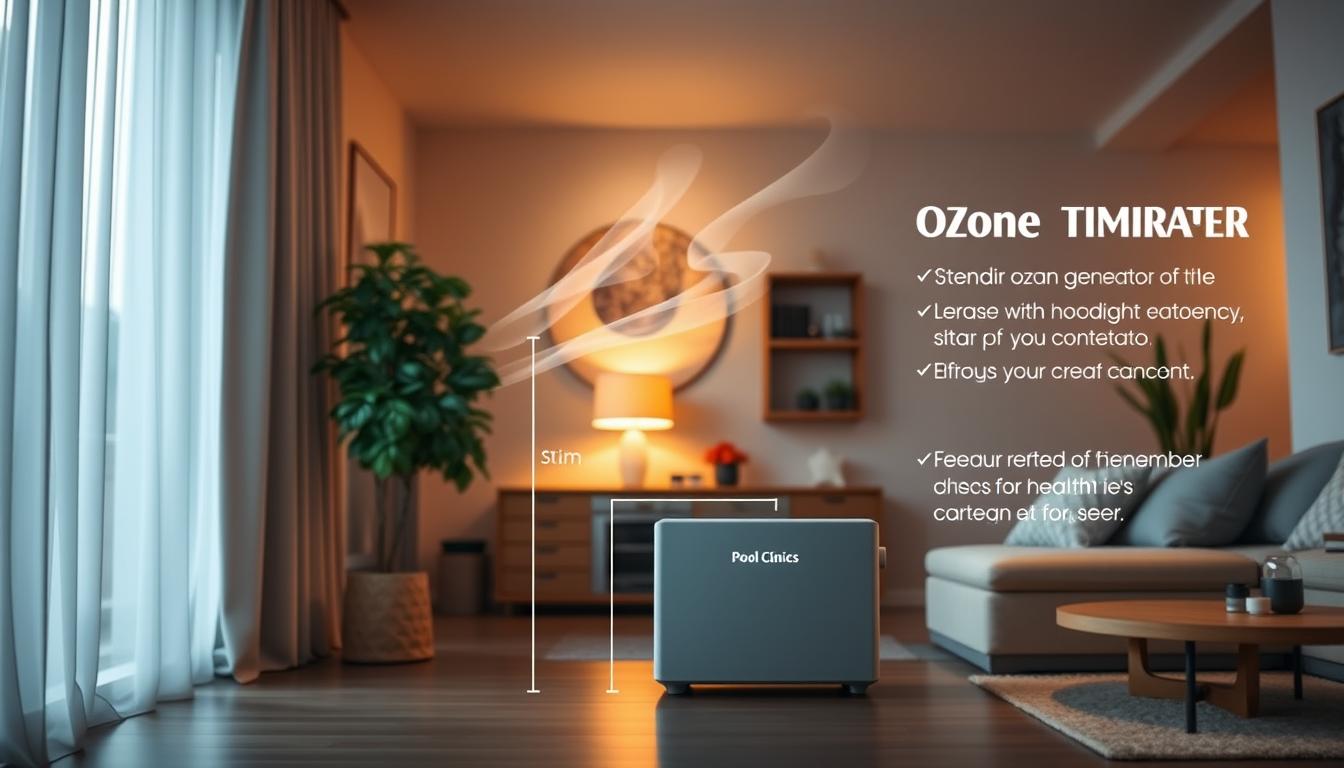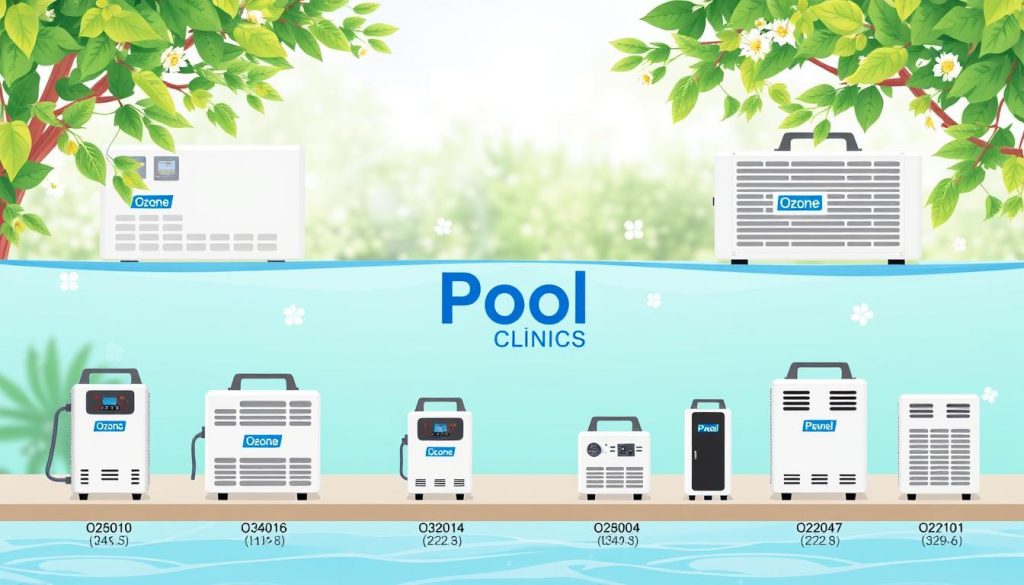
Stubborn odors, mold growth, and air quality issues can be tough to tackle with regular cleaning. Ozone generators offer a solution. These machines produce ozone gas, which neutralizes odors and eliminates mold and bacteria. Selecting the right ozone generator for homes is crucial for effective treatment.
Ozone output is measured in milligrams per hour (mg/h). The required ozone machine capacity depends on various factors. These include the area size, odor level, and specific application. Calculating ozone requirements ensures effective treatment without harmful overexposure.
This guide will help you understand residential ozone generator sizing. We’ll explore factors affecting ozone output and how to determine the right capacity. By the end, you’ll be able to choose the perfect ozone generator for your home.
Key Takeaways
- Ozone generators produce ozone gas measured in milligrams per hour (mg/h)
- The right size ozone generator depends on the area size, odor level, and specific application
- Around 1000 mg/h of ozone output per 100 square feet is needed for thorough decontamination
- Humidity and temperature can significantly impact ozone production
- Safety precautions include proper ventilation and avoiding exposure to high ozone levels
Understanding Ozone Generator Capacity
Choosing the right ozone generator requires understanding its capacity for your specific use. Capacity is measured in grams per hour (g/h). This shows how much ozone the unit produces in an hour.
However, actual ozone output can vary. Several factors affect the amount of ozone produced. It’s important to consider these when selecting a generator.

Factors Affecting Ozone Output
Key factors influencing ozone output include:
- Feed gas type (air or oxygen)
- Feed gas flow rate
- Ozone concentration levels
- Ambient temperature and humidity
Air-fed and oxygen-fed generators produce different ozone concentrations. For example, an air-fed generator may produce 1 g/h from 6 LPM of air. An oxygen-fed generator could produce 5 g/h from 0.5 LPM of oxygen.
These factors are crucial when choosing the right generator capacity. Consider them carefully to meet your specific needs.
Measuring Ozone Production in Grams per Hour
Ozone generation is typically measured in grams per hour (g/h). This shows the generator’s production capacity. However, this measurement alone doesn’t fully represent treatment effectiveness.
Ozone concentration levels also matter. These are measured in grams per cubic meter (g/m³) or parts per million (ppm). Both production and concentration affect the ozone application’s efficacy.
| Application | Ozone Output (g/h) | Ozone Concentration (ppm) |
|---|---|---|
| Residential Air Purification | 1-5 | 0.1-0.5 |
| Commercial Air Treatment | 5-20 | 0.5-2.0 |
| Industrial Water Treatment | 50-500 | 1.0-10.0 |
| Odor Control | 10-100 | 1.0-5.0 |
When calculating ozone dosage, consider both output and concentration levels. This ensures you choose the right generator for your needs. Understanding these factors helps you make an informed decision.
Selecting the proper ozone generator is crucial for optimal performance. Consider all aspects to find the best fit for your specific application.
Determining Your Ozone Requirements
Choosing the right ozone generator size is crucial for optimal results. Several key factors must be considered when calculating ozone requirements. This ensures efficient operation for your specific application.
Calculating Treatment Area Size
Start by measuring your ozone treatment area. For rectangular spaces, multiply length by width to get square footage. A 20 by 15-foot room equals 300 square feet.
You’ll need about 1,000 mg/h of ozone output per 100 square feet. This helps determine what size ozone generator you need.
Considering Ozone Concentration Levels
Different industries require varying ozone dosages. Consider the desired concentration levels for your specific application. The table below illustrates ozone dosages for various purposes:
| Industry/Application | Ozone Dosage | Purpose |
|---|---|---|
| Drinking Water | 3g/m3 | Sterilization, Decolorization, Deodorization |
| Industrial Cooling Water | 0.5-1g/m3 | Sterilization, Algae Removal |
| Hospital Sewage Treatment | 10-20g/m3 | High Efficiency Rapid Disinfection & Sterilization |
| Swimming Pools | 1-2g/m3 | Disinfection, Humus Decomposition, Water Quality Stabilization |
| Medical Instruments | 50-100mg/m3 (20ppm) | Space Disinfection |
Ozone concentrations vary greatly depending on intended use. Choose a generator with appropriate output for your ozone treatment area. This ensures desired concentration levels are achieved.
Accounting for Temperature and Humidity
Temperature and humidity affect ozone generator performance. High humidity can reduce effectiveness, especially in corona discharge models. In humid environments, consider a more powerful generator or different technology.
Ceramic plate systems may work better in high humidity. Consider all factors to select the right ozone generator for your needs.
Consult an experienced supplier for help choosing the best unit. They can guide you in making an informed decision based on your specific requirements.
What Size Ozone Generator Do I Need?
Choosing the right ozone generator depends on the space you want to treat. Ozone generator capacity is measured in milligrams per hour (mg/hr). This output determines how effective the treatment is in a given area.
Matching Generator Capacity to Room Size
An ozone generator should produce about 1,000 mg/hr of ozone for 1,000 cubic feet of space. This ensures permanent odor removal. BoiE ozone generators with 1,800 mg/hr capacity can treat a 180 sq. ft. room with 10 ft. ceilings.
These generators are suitable for vehicles or individual rooms. The right size depends on the space you need to treat.
Recommended Ozone Outputs for Various Applications
The application also affects the ozone generator size you need. BoiE generators produce concentrated ozone to oxidize VOCs, mold, and contaminants during clean-ups.
Shock treatments require 5 ppm ozone concentration. This is typically generated through 1,000 mg/hr of ozone for 1,000 cubic feet of space.
| Application | Recommended Ozone Output |
|---|---|
| Vehicle interiors | 3,000-4,000 mg/hr |
| Hotel rooms | 6,000-8,000 mg/hr |
| Basements or industrial spaces | 10,000+ mg/hr |
Adjusting for Specific Treatment Goals
Consider your specific treatment goals when choosing an ozone generator. Ozone exposure has been proven to deactivate SARS-CoV-2 and other coronavirus strains.
During the 2003 SARS pandemic, ozone had a 99.22% kill rate. It can disinfect unoccupied spaces by creating high air concentrations.
Ozone generator treatment may need repeated applications to fully address an issue. Adjust the output and duration based on your goals for optimal results.
Conclusion
Selecting the right ozone generator depends on your specific needs. Consider the space size, odor level, and treatment goals. These factors determine the ideal ozone generator size for your situation.
A 1000 mg/h ozone output works for 100 square feet. Larger spaces or severe odors may need higher capacity. Temperature and humidity can affect ozone production and effectiveness.
Assess your needs and review generator specs carefully. This helps you choose a unit for safe, efficient odor removal. The right size ensures a fresh, clean indoor environment.
Remember, bigger isn’t always better for ozone generators. Find a unit that matches your specific application. This ensures optimal results and long-lasting performance.







